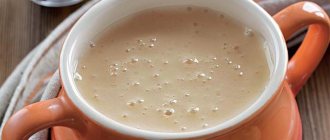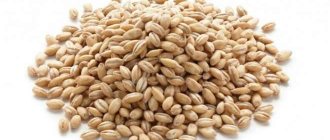Healthy porridges for the stomach and intestines are prepared from rice, buckwheat, pearl barley, whole oats, and millet. Their regular use helps improve digestion and peristalsis, accelerated evacuation of waste and toxins, and replenishment of vitamins, micro- and macroelements. The inclusion of cereal porridges in the daily menu becomes an excellent prevention of gastritis, ulcerative lesions of the stomach and duodenum.
Cereal porridges are not only tasty, but also have a pronounced medicinal effect
Characteristic features of porridges
One of the most effective methods of treating gastrointestinal pathologies is following a strict or gentle diet. It necessarily includes cereal porridges made from whole or crushed cereals. They are highly nutritious, provide quick saturation, and eliminate the deficiency of biologically active substances. The healthiest porridge for the stomach and intestines is the one that, after consuming it, increases physical performance and does not cause signs of indigestion - heartburn, belching, bloating. Most cereals have a mild laxative effect, but there are also grains among them that help cope with diarrhea during intoxication of the body.
Composition of cereals and beneficial properties
The therapeutic effects of porridges are based on the properties of the ingredients from their chemical composition. It differs somewhat among different cereals, but also has a lot in common. Buckwheat and rice are considered cereals that are good for the intestines. And in the treatment of stomach diseases, oatmeal and millet are more often used. By consuming any cereal porridge, a person can be sure that a large number of useful organic compounds are entering his body.
Carbohydrates, mainly starchy substances
Carbohydrates nourish the tissues of the brain and heart muscle, and participate in the formation of a key component for liver function - glycogen. They prevent excessive blood clotting and fill the intestines with the necessary active substances to fight infections.
Omega-6 unsaturated fatty acids
Polyunsaturated fat-soluble acids dissolve cholesterol blocks in blood vessels, increase the firmness and elasticity of veins, arteries, capillaries, and normalize their permeability. These are universal immunomodulators that ensure the body's immunity to the action of external and internal negative factors.
Phytosterols
They prevent premature aging of the body by increasing the production of estrogen and prevent the destruction of cells by free radicals. They reduce the severity of painful sensations, increase the production of collagen and hyaluronic acid, and contribute to the optimal functioning of the digestive system.
Minerals
Porridges contain mainly silicon, magnesium, potassium, phosphorus, manganese, cobalt, selenium, and iron. Without these bioactive substances, it is impossible for any of the life systems to function. Sufficient intake of micro- and macroelements into the body is the key to good skin condition, healthy hair and nails.
Cellulose
When you have an upset stomach, you eat porridge because of its high content of coarse fiber. It is not characterized by high nutritional properties. Fiber performs a cleansing function. It is not broken down by the digestive enzymes of the human body, but is processed by beneficial intestinal microflora. Eating porridge for gastritis or poisoning helps improve the composition of the microflora, and, consequently, optimize the functioning of the stomach.
Cereal porridges have a beneficial effect on the functioning of the intestines, stomach, liver and gallbladder
Harm of cereals to humans
Porridges are useful for stomach ulcers, inflammation of the large and small intestines, and various forms of gastritis. But their excessively frequent use in large quantities can negatively affect the functioning of the entire body:
- increased glucose and fatty acids in the blood;
- development of caries;
- accumulation of mineral salts in the cavity of small and large joints, their deposition in the form of crystals;
- increasing the overall acidity of the body, predisposing to the development of diseases;
- the formation of a deficiency of certain minerals (iodine, calcium, sulfur, chlorine, sodium), of which there is very little in cereals.
It should be borne in mind that some porridges have a fairly strong fixing effect, for example, rice. It cleanses the gastrointestinal tract well, but provokes problems with bowel movements. And this is especially harmful for proctitis, hemorrhoids, and anal fissures.
Recommendation! Despite all the benefits of cereals, they can provoke both local and systemic allergic reactions. Therefore, caution should be exercised when consuming them in large quantities, which often occurs when cleansing the digestive organs.
Diabetes
In diabetes, the body does not produce enough insulin or does not use it effectively. Blood glucose levels are elevated, which is dangerous to health.
The benefits of millet are its high content of dietary fiber, vitamins and minerals, which help control blood sugar levels.
High fiber content slows down digestion and increases blood sugar levels more slowly.
A simple recipe for diabetes:
- Take 1 tsp once a week for a long time. millet flour.
The study confirms that consuming millet in case of type 2 diabetes for 90 days reduced the levels of glucose, total and “bad” cholesterol.
Therapeutic effect of cereals
When cooking porridge, a lot of useful mucus is formed. They envelop the walls of the gastrointestinal tract, protecting them from damage. If a person regularly includes cereals in his diet, he is much less likely to suffer from poisoning, intoxication, and diseases caused by pathogenic bacteria, viruses, and fungi.
Ulcerative lesions
An ulcer is a chronic, recurrent disease of the stomach, which is accompanied by the formation of a defect in the gastric mucosa and the tissues located underneath it. The main symptom of severe pathology is epigastric pain on an empty stomach or after eating, often radiating to the back and chest. The ulcer also manifests itself with nausea, vomiting, vomiting, and belching. Cereals will help reduce the severity of these clinical manifestations. What cereals can you eat if you have a stomach ulcer?
- oatmeal normalizes acidity and protects the walls of the stomach, promotes healing of the mucous membrane;
- Buckwheat for stomach ulcers eliminates irritation of the mucous membrane;
- millet activates the work of parietal cells and the synthesis of hydrochloric acid, therefore it is used during the period of remission.
It is better to exclude corn porridge from the diet if you have a stomach ulcer. It contains too much coarse fiber. As it passes through the digestive tract, it will irritate tissues damaged by inflammation. Also, its digestion takes several hours, which is unacceptable for this disease. Barley porridge is approved for use for stomach ulcers. But only good quality cereal is used, and when cooking it is important to take into account that the consistency of the finished dish should be liquid and at the same time viscous.
Pea porridge for stomach ulcers is strictly prohibited, especially during relapses. Its use can cause excessive gas formation, which impairs peristalsis even in a healthy person. And with erosive lesions there is a risk of developing putrefactive and fermentation processes.
Wheat porridge is very useful for stomach ulcers. But when cooking it, you need to add enough water so that the finished dish is viscous. Then thick mucus will form a membrane on the surface of the damaged tissues, impenetrable to aggressive gastric juice.
Colitis
Colitis is an inflammatory disease of the colon of infectious, ischemic, drug or other origin. The pathology occurs with pain, indigestion (constipation, diarrhea), and flatulence. The patient's diet should consist of pureed porridge. They are prepared in water or using low-fat fish and meat broths, adding a little butter or vegetable oil. What cereals can you eat if you have intestinal colitis?
- rice Adsorbs waste, toxic substances, tissue breakdown products, and then evacuates them from the body;
- buckwheat Normalizes the production of hydrochloric acid and pepsin by cells located in the gastric mucosa;
- oatmeal Reduce the severity of pain, burning, and stinging after eating foods rich in fats, spices, and salt;
Semolina porridge for intestinal colitis promotes the production of bile, which is necessary for optimal digestion. The bolus of food moves faster, so there is no pain. In therapeutic diets for acute, subacute or chronic inflammation, there is no place for cereals, after consumption of which gas formation increases. Corn, millet cereals, and peas are prohibited.
On a note! Colitis is characterized by frequent alternations of diarrhea and constipation. Therefore, if you have diarrhea, it is advisable to eat rice dishes that have restorative medicinal properties. And in case of constipation, improving the passage of intestinal masses is facilitated by the addition of vegetable oil to any porridge and a sufficient amount of fluid consumed per day.
Gastrointestinal disorders
An unbalanced, irrational diet often causes constipation, which causes not only physical, but also psychological discomfort. Daily consumption of cereals will help you cope with them. They contain non-digestible fiber, which is a natural hydrophilic polymer that can attract fluid into the intestinal lumen. The plant fibers inside the stool swell, softening the stool and preventing constipation. Which porridge weakens the intestines:
- buckwheat;
- pearl barley
- millet
These cereals stimulate intestinal motility and promote the evacuation of its contents. And the presence of minerals and vitamins in their composition helps to replenish the reserves of bioactive substances in the shortest possible time. Wheat porridge strengthens or weakens the intestines - its consumption has virtually no effect on peristalsis. Its composition is well balanced, so this cereal can be used both for constipation and diarrhea.
Oatmeal strengthens or weakens the intestines - laxative properties are more typical for this porridge. It is useful to use it after suffering infections in the treatment of which antibiotics were used. Cereals simultaneously improve bowel movements and restore intestinal microbiocenosis. How oatmeal also affects the intestines:
- increases the moisture content in feces;
- stimulates the production of mucus by the glands, which facilitates their sliding.
Rice strengthens or weakens the intestines - this porridge should be used as a remedy for diarrhea. Cereals absorb liquid from stool, slowing down their progress. But rice is used for intestinal disorders when it is of non-infectious origin. Otherwise, pathogenic bacteria and viruses will remain inside and spread throughout the body.
Important! Cereal porridges with a laxative effect can accelerate the elimination of pharmacological drugs. And this will significantly reduce the effectiveness of the therapy.
Cooking methods
There are several basic ways to prepare millet. They are suitable for everyday menu:
- Recipe with milk. Main ingredients: 35 g butter, a glass of millet, sugar and salt to taste, 2 glasses of milk and water. The cereal is poured into a pan and boiled. During boiling, foam appears, which must be removed and then the heat reduced. You need to continue cooking until the water is absorbed into the millet. Separately, boil the milk and add it to the cereal. You need to simmer over low heat until completely absorbed. The porridge must be salted, if desired, add sugar and season with oil.
- Vegetable soup with millet. Main ingredients: small carrots, 2 potatoes, a glass of milk, parsley, 1 tbsp. l. sour cream, salt, 60 g millet. Cook the cereal over low heat until cooked. You need to peel the potatoes and cut them into cubes, the carrots also need to be peeled and finely chopped. Then you need to prepare vegetable broth, and grind the boiled vegetables in a blender. Mix the prepared porridge with vegetable stew and make a puree from this mixture. Add boiled milk, put it back on the stove and bring to readiness. Greens and sour cream are added at the very end.
The healthiest cereals for the gastrointestinal tract
The benefits of cereals can hardly be overestimated. They form the basis of dietary nutrition and speed up recovery. In the assortment of supermarkets, many cereals with exotic names have appeared for the preparation of porridges and side dishes that are tasty, healthy, and have medicinal properties. But they are not able to compare with the cereals familiar to our country with a balanced chemical composition.
Oatmeal
Oatmeal is the first choice porridge for the stomach. With its regular use, you can forget about sludge in the body, belching, heartburn, constipation and other health problems. Oatmeal for gastritis of the stomach helps to quickly reduce the severity of symptoms by reducing the production of hydrochloric acid. The thick mucus contained in it inhibits the growth and reproduction of gastritis pathogens - the pathogenic bacteria Helicobacter pylori. What else is the benefit of oatmeal for the stomach:
- accelerates the movement of the food bolus;
- adsorbs waste and toxins on its surface;
- prevents the development of inflammatory processes;
- stimulates the restoration of ulcerated tissues in stomach diseases caused by increased production of hydrochloric acid.
This cereal is an excellent source of vitamins, minerals and antioxidants, including unique ones. Hercules porridge is useful for the stomach, including due to the presence of a high quantitative iron content in it. It is this microelement that is lost during bleeding, which is not uncommon for some pathologies. Therefore, oatmeal is indispensable for stomach ulcers, a disease the course of which is often complicated by bleeding.
It is also useful for stomach pain that occurs when hydrochloric acid comes into contact with microtraumatized areas of the mucosa. Oatmeal, prepared in the correct way, has a moderate analgesic effect:
- the cereal needs to be filled with water - about 2 cups per glass;
- bring to a boil, cook until thickened for 30-40 minutes;
- add butter;
- simmer for another five minutes, turn off the heat;
- let stand covered for 5-10 minutes.
Oatmeal made with water is healthier for the stomach than cooked with milk or broth. It contains few proteins, so it does not require much hydrochloric acid to break them down. If your stomach hurts after eating oatmeal, you should exclude it from your diet and consult a gastroenterologist.
This is interesting! Whole or crushed cereals are used as a scrub. But not for the skin - oatmeal for the intestines is used as a cleanser. It binds nutrient breakdown products and removes them during bowel movements. The benefits of oatmeal for the intestines include the rapid elimination of symptoms of flatulence.
Buckwheat porridge perfectly cleanses the gastrointestinal tract of toxic substances
Buckwheat
The healing effect of buckwheat for the stomach and intestines is difficult to overestimate. It contains fiber, which controls the activity of the entire digestive system. The benefit of buckwheat for the intestines is the correction of stool and its stabilization. Therefore, cereals are indicated for constipation and, conversely, diarrhea. The benefits and harms of buckwheat for the stomach are closely interrelated and are based on the bioactive organic compounds it contains. In combination they exhibit the following therapeutic activity:
- resolve inflammatory swelling;
- evacuate waste and toxic substances;
- dissolve harmful mineral salts and remove them with feces;
- prevent the proliferation of pathogenic microorganisms;
- improve blood circulation.
But sometimes after buckwheat there is heaviness in the stomach. The cause of discomfort is the high concentration of fiber. Why does buckwheat hurt your stomach? It takes a lot of acid to break it down, which leads to irritation of the mucous membrane. The situation is aggravated if there are microtraumas on it. Therefore, when asked by patients whether buckwheat can cause stomach pain, gastroenterologists answer positively. In this case, its use should be abandoned.
Important! Very often, using buckwheat for stomach pain leads to the exact opposite effect. The intensity of the discomfort increases, signaling the need for a thorough examination for the presence of pathologies.
Is it possible to eat buckwheat if you have a stomach ulcer? This is one of the cereals allowed for this disease. But only if the finished dish has a viscous consistency. Buckwheat is no less useful for the intestines. It helps speed up the passage of feces and eliminates putrefactive processes. The benefits and harms of buckwheat for the intestines are also determined by the presence of fiber in the composition. In case of acute inflammation of the walls, it can provoke their damage.
Pearl barley
Barley for the stomach and intestines is a source of insoluble fiber. Cereals prevent the development and formation of gallstones, reduce the secretion of bile acid, and reduce triglyceride levels. Is pearl barley good for the intestines? It is like a compact whisk, clearing deposits of undigested food products from its walls. How else does pearl barley affect the intestines?
- helps to quickly remove feces;
- Prevents constipation due to its mild laxative effect;
- pearl barley porridge cleanses the intestines not only of toxins, but also of multiplied harmful bacteria;
- regenerates damaged mucous membranes.
Pearl barley porridge for the intestines is not required in large quantities. It is often prepared in the form of a decoction (at the rate of 250 g of cereal per one and a half liters of liquid).
Is it possible to eat pearl barley if you have a stomach ulcer? Yes, but with some restrictions. Eating porridge is advisable during the period of remission, in the absence of pain and bleeding. Then pearl barley for the stomach will become a kind of protection against exacerbations. Bioactive substances in cereals trigger repair processes and accelerate the healing of the mucous membrane. Whether pearl barley is hard on the stomach or not, it requires a lot of hydrochloric acid to digest it, so the likelihood of discomfort after eating the porridge is quite high.
Rice porridge has a strengthening effect, so it is often used to treat diarrhea.
Rice
Rice contains a lot of proteins that improve blood circulation and replenish tissue reserves of nutrients necessary for their regeneration. They stop low-grade inflammatory processes by optimizing biochemical reactions. Proteins not only take part in them, but also serve as catalysts. Therefore, rice is irreplaceable for the stomach and intestines.
Cereals contain a huge amount of water-soluble vitamins and amino acids. These bioactive substances of rice are especially in demand for indigestion. They bind toxins, including pathogenic bacteria, and then remove them from the body. Rice is good for the stomach for the following reasons:
- has a strengthening effect;
- helps improve intestinal microflora, and, consequently, digestion;
- neutralizes and removes toxins.
Is it possible to have rice if you have a stomach ulcer? Viscous and crumbly porridge is often included in the therapeutic diet. Cereals contain many B vitamins, which prevent erosions from bleeding. And rice for the intestines is in demand for chronic diarrhea. But not of infectious origin, but provoked by dietary errors or stress. Rice is heavy on the stomach or not - it takes a long time to break down in the gastrointestinal tract and slowly moves through it. Therefore, it is better to eat porridge often, but little by little.
Manna
Is semolina porridge good for the stomach? It has a healing effect due to the presence of B vitamins and biotin. These bioactive substances stimulate the strengthening of the body's defenses and reduce the likelihood of relapses of chronic diseases. They improve the functioning of the stomach, large and small intestines, gallbladder, liver, and pancreas. Bioactive substances increase performance and tone. Semolina porridge is useful for the stomach for the following reasons:
- protects the walls of the stomach;
- reduces the activity of harmful bacteria;
- removes mucus and toxic substances.
Nutritionists recommend eating semolina for stomach pain. Cereals can relax smooth muscles. And this leads to the elimination of spasms and the painful sensations caused by them. Is semolina porridge good for stomach ulcers? Its use is even recommended. The cereal breaks down well, so it does not burden the gastrointestinal tract. Semolina porridge for stomach ulcers is especially recommended during relapses.
Millet
Millet porridge for the stomach is used as a remedy. It is prepared from millet, which is a record holder for the content of micro- and macroelements. It contains especially a lot of phosphorus, iron, potassium, and magnesium. This is one of the few grains that contains sulfur, which has anti-inflammatory and antioxidant properties. Therefore, millet porridge for the intestines is often used for colitis. It is characterized by the following therapeutic effects:
- improvement of intestinal microbiocenosis by increasing the population of bifidobacteria;
- replenishes the supply of nutrients in cells necessary for their regeneration.
However, millet porridge is difficult for the stomach due to the presence of a huge amount of fiber in it. It can irritate already damaged mucous membranes. It is better to eat millet porridge if you have a stomach ulcer or gastritis after exacerbations, during the period of remission.
On a note! For medicinal purposes, it is advisable to use millet for cooking porridge. During production, cereals are freed from flower films and most grain shells, as well as from the germ. The polished grain is rough to the touch and does not have a very bright color or shine. But it is devoid of most of the fiber that irritates the mucous membranes of the gastrointestinal tract.
Flaxseed porridge has few calories, but a lot of vitamins, micro- and macroelements
Losing weight on millet
Thanks to the cereals we are studying, you can lose up to 10 kilograms within 2-3 weeks. For maximum effect, you must fully follow the advice of nutritionists presented below.
In addition to the fact that the body will become slim, excess fat will disappear, and a colossal cleansing of harmful substances and excess fluid will also occur.
Fasting days
If you arrange such days more often, you can easily get rid of 1 kilogram of weight per day. The condition of the skin and hair will also improve, metabolism will be regulated, and peristalsis will be normalized. So, the diagram:
Boil half a glass of millet and divide it into equal 4 parts. Salt, sugar and butter are strictly prohibited. As a last resort, you can add vegetables (green). Along with the porridge, you should drink chamomile or green tea throughout the day (at least 2 liters of liquid per day).
Millet diet
For the diet, we need the same cereals, yogurt without additives, vegetables, herbs, apples (oranges), low-fat kefir (ryazhenka).
| Diet plan | |
| Morning | porridge (without sugar, salt and oil), banana or low-fat yogurt |
| Dinner | porridge, vegetable soup without meat, salad without oil and salt |
| Afternoon snack | carrot, orange |
| Dinner | porridge, low-fat kefir (ryazhenka) |
Continue this way for 4 days, then break for 2 days. During a break, you should not pounce on low-fat, smoked and other harmful foods. At the same time, do not forget about drinking plenty of fluids, exercising, walking in the fresh air and giving up bad habits.
Important: diets and fasting are strictly prohibited for pregnant women and persons with acute phases of illness.
Studying the properties of millet cereals, scientists came to one general conclusion. It is healthy, nutritious, and moreover, medicinal. But there is a point that should also be paid attention to - this is the benefit for a person’s appearance. If from childhood you feed your beloved child such dishes as the cereals we describe, then everything will be fine not only with his thinking abilities, the state of his internal organs and systems. Your child will be beautiful thanks to velvety skin, thick and silky hair, beautiful teeth and strong body. He will be stately, active, intelligent and creatively developed. And it all lies in only one thing - proper and healthy nutrition.











